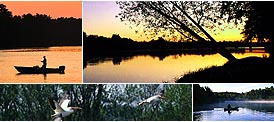


Wildlife Information
Alligators
Black Bear
Whooping Crane
Bald Eagle
Manatee
Florida Panther
Brown Pelican
Florida Wildlife - Whooping Crane
Once very close to extinction, the whooping crane is making a comeback, thanks to conservation efforts over the last few decades. In 1937, only two small breeding populations of the whooping crane remained; a nonmigratory population in southwestern Louisiana, and a migratory population which nested in Canada and wintered on the Texas Coast. Today, there are nearly 300 whooping cranes in the wild and in captivity.
Before settlers moved west, whooping cranes nested from Illinois to southern Canada, sharing their nesting grounds with the grizzly bear, bison, and gray wolf. Whooping cranes migrated to areas extending from the Carolinas to Mexico to spend the winter. But with the settlement of the West, much of the crane's prairie nesting grounds were converted to pasture and agricultural lands. Whooping cranes therefore disappeared from the Great Plains, finding safe refuge far north in Canada at the Wood Buffalo National Park. This was not known until 1954, when a pilot spotted a pair of whooping cranes at the park. And in 1941, records show only 16 birds had migrated to wintering grounds on the Aransas National Wildlife Refuge on the Gulf Coast of Texas. The tallest bird in North America, the whooping crane stands 5 feet tall with a long, sinuous neck and long legs. Its snowy white body feathers are accented by jet-black wingtips and a red and black head with a long, pointed beak. The wings measure about 7 feet across. Whooping cranes fly with slow wingbeats and the necks and legs fully extended. The whooping crane's call, from which it derives its name, has been described as a shrill, bugle-like trumpeting. Whooping cranes nest in marshy areas among bulrushes, cattails, and sedges that provide protection from predators as well as food. They eat insects, minnows, crabs, clams, crayfish, frogs, rodents, small birds, and berries. Whooping cranes do not reach breeding maturity until they are 4 years old, and they establish life-long mates. Their courtship dance, which begins in late winter, consists of loud vocalizations, wing flapping, head bowing, strutting, and tremendous leaps into the air by one or both birds. This behavior may also occur when birds are defending their territory. Whooping cranes usually nest once each year, unless their first clutch is destroyed they sometimes will lay another. Also, occasionally a pair will skip a nesting season if conditions are unsuitable or for no apparent reason. Normally two eggs are laid in late April to mid-May, with hatching 1 month later. The parents share incubation and rearing duties, but females take the primary role in feeding and caring for the young. Usually only one of the two chicks is raised. Whooping crane chicks have reddish-cinnamon colored feathers. Slowly over their first winter, juvenile plumage is replaced, and by the following spring it is mostly white, with full adult plumage being reached by late in the second summer. Fall migration begins in September, and whooping cranes normally migrate in small flocks of less than 10. They arrive at Aransas National Wildlife Refuge in Texas between late-October and mid-November, where they will spend about 6 months. In April, the birds make the 2,600-mile trip back to Wood Buffalo National Park in Canada. It has been estimated that between 500 and 1,400 whooping cranes inhabited North America in 1870. While never very numerous, several factors contributed to their rapid decline. Many cranes have died from collisions from power lines. Substantial numbers were lost to illegal shooting for meat and sport. Some have died of avian tuberculosis, avian cholera, and lead poisoning. Due to their long migration route, whooping cranes also are vulnerable to natural disasters such as hail storms or drought. The whooping crane's delayed breeding maturity and small clutch size make the population as a whole less capable of rebounding from these threats. Various efforts have helped the whooping crane over the years. Passage of the Migratory Bird Treaty Act of 1918 gave protection to whooping cranes and other birds, thus thwarting illegal shooting. Canada's Wood Buffalo National Park, while established in 1922 to protect the buffalo, was a safe haven for the last nesting population of the whooping crane at that time. In 1937, the Aransas National Wildlife Refuge was established to protect the wintering area of the remaining whooping cranes. In 1967, the whooping crane was designated as an endangered species (under a law that preceded the Endangered Species Act of 1973), meaning it was considered in danger of extinction throughout all or a significant portion of its range. In 1967, the U.S. Fish and Wildlife Service began a whooping crane recovery program, relying on an extensive captive breeding effort which has been met with many challenges due to the whooping crane's sensitivity to human contact. To date, three facilities are now captively rearing whooping cranes for reintroduction into the wild, and flocks have been reintroduced into the wild at two sites. These efforts began because of the risk of losing the entire wild flock of whooping cranes due to a natural disaster such as disease or hurricane, and to help increase whooping crane numbers. Since whooping cranes normally lay two eggs but only raise one chick, in one experiment, Canadian and American biologists removed the "extra" eggs from nests in the wild and brought them to the Patuxent Wildlife Research Center in Laurel, Maryland, where they were artificially incubated and later used to establish a captive flock. From 1967 through the present, many "extra" eggs have been transferred from the wild to the Patuxent center and other whooping crane captive breeding facilities. Artificial insemination also proved successful in increasing the number of eggs laid by captive cranes. Once a crane laid a clutch of eggs, the eggs were removed to be incubated either artificially or by a sandhill crane, a closely related species. The whooping crane would then lay a second clutch of eggs. An effort to create a wild flock with an alternate migratory route was initiated in 1975, using sandhill cranes as "foster parents." Whooping crane eggs were placed in the nests of sandhill cranes on their nesting grounds at the Grays Lake National Wildlife Refuge in Idaho. The sandhills reared the chicks as their own, teaching them feeding habitats and ultimately a new 850-mile migratory path to the Bosque Del Apache National Wildlife Refuge in New Mexico. Unfortunately, these whooping cranes became so accustomed to their sandhill parents that they would not mate with other whooping cranes. Today, there are 8 whooping cranes left in this flock. In 1989, a second captive flock was established at the International Crane Foundation in Baraboo, Wisconsin, a conservation organization dedicated to the preservation of cranes worldwide. In addition to birds from the Patuxent center, some of these whooping cranes have been used for reintroduction efforts. In February 1993, a nonmigratory flock of 14 captive-reared whooping cranes was reintroduced on the Kissimmee Prairie in Florida. Since then, 19 more birds have been released at this site. Twenty-five more birds will be released in the winter of 1994-95, and annual releases of around 20 birds are scheduled for the next 8 years. Bobcat predation, which is common among sandhill crane populations in the same area, has been the greatest cause of mortality for this flock. From 1992 to the present, 18 whooping cranes have been transferred to a facility in Calgary, Canada, to establish a third captive flock. Presently, biologists are evaluating sites in Canada for the reintroduction of a migratory flock of whooping cranes later this decade. Thanks to these efforts, the whooping crane population has survived and continues to increase. The U.S. Fish and Wildlife Service's whooping crane recovery program has been so successful that other countries have adopted similar methods to protect other species of crane that are also threatened.
Information provided by:
Fish and Wildlife Service
















